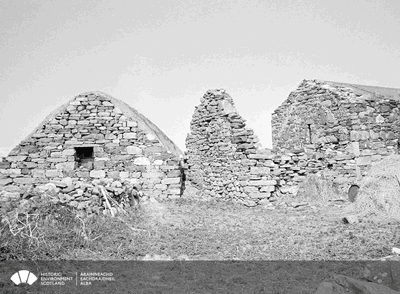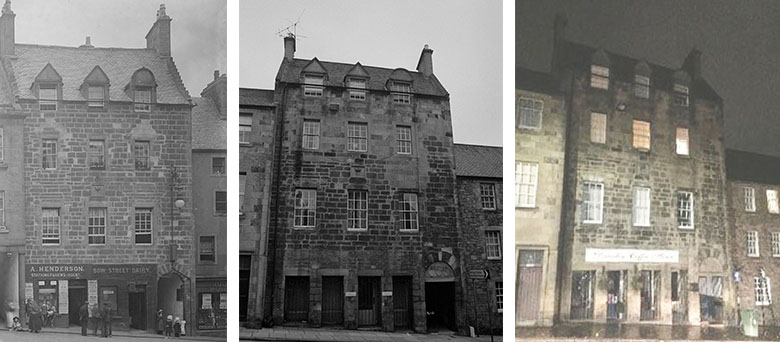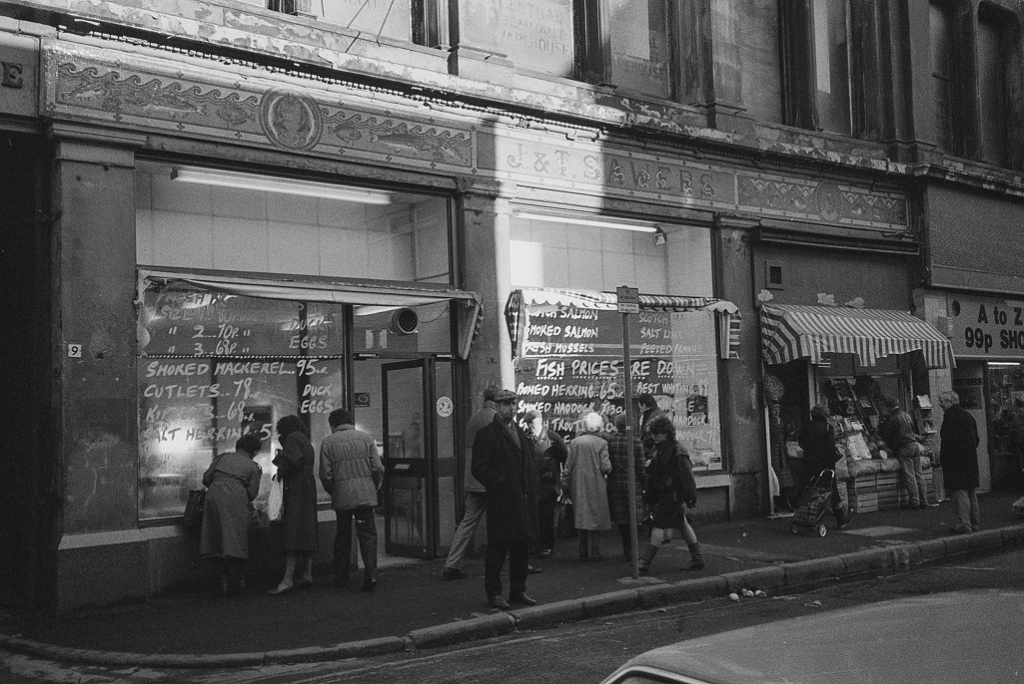Do you remember what your street looked like when you were growing up? Or perhaps you wonder how your town centre once looked? Or maybe how buildings in Scotland in the 1980s compare to now? Thanks to our Digital Projects team in HES Archives, this is now becoming possible – all from the comfort of your own home!
A jump to the left and a step to the right (all around Scotland)
In the 1970s and 1980s investigators from the Scottish Development Department (SDD) photographed thousands of buildings across Scotland, both interiors and exteriors.
The photographs range from idyllic crofts in the Highlands to farms on Orkney; large estates in Fife to tenement buildings in Glasgow. The interior images give a glimpse into life and home design throughout Scotland. My personal favourite photograph shows a home owner’s proud collection of teddy bears!

An elaborate teddy bear display inside a house in Glasgow, 1981
They got caught in a celluloid jam
Previously, these photographs could only be accessed by visiting our Edinburgh Library and Searchroom. Now, over 55,000 images from this collection are viewable online via Canmore, meaning a trip to the physical archive is no longer necessary. The collection’s increased accessibility opens many possibilities to explore the photographs. A particularly enjoyable way is to compare site photographs with current or previous records in our archive – what has changed, and what has stayed the same? To this end, I’ve compiled a few of my favourite comparisons from across Scotland.
Then and now
Capturing age and rarity
This byre stands on the largest island in the Sound of Harris, Berneray. It might not be much to look at, but this is a category A listed building. Known as ‘Gunnraidh MhicLeòid’ sabhal agus bàthach, a’ gabhail a-steach balla-glèidhidh (‘Macleod’s Gunnery’ barn and byre), the buildings in this complex are an important record of how rural communities lived and worked in the Outer Hebrides. You can find out more about the importance of this site and a bit of its history over on our Heritage Portal.
The first image was taken in 1984, the second in 2009. You can see some repair work has taken place on the smaller building, where a thatched roof has been added.

Farm buildings in Berneray, Risgary, in the Outer Hebrides.
A bit of Peace
This Category C listed church in Kirkwall is one of several building on Orkney designed by local architect Thomas Smith Peace.
Kirkwall Baptist Church was completed in 1888 (known as the United Presbyterian Hall, when it was built). It looks much the same in these two images from 1985 and 2015. Can you spot the minor changes to the exterior?

Baptist Church, Kirkwall, Orkney. 1985 and 2018.
Female industrial school
While the phrase “female industrial school” might conjure up images of women forging a career in traditionally male dominated roles in the minds of a modern audience, this was actually a school to teach women how to be industrious around the house. A plaque at the former school proclaims:
On this site in 1848 Lady Matheson the wife of the owner of Lewis opened a school to provide young ladies with the opportunities to learn a range of domestic activities and crafts.
If you compare the 1982 and 2015 photos from our digital archives, you can see the unfortunate decline in the condition of this category B-listed property in Stornoway. It has since been added to the Buildings at Risk Register. However, there is hope for the future. It has recently secured planning permission for conversion into flats. Hopefully a site comparison in another 30 years will show some restoration of this historic landmark.

Former Lady Matheson’s Industrial Female School, 74 Keith Street, Stornoway. 1982 and 2015.
You’re into the timeslip

Darnley’s House on Bow Street, Stirling. c.1900, 1983, 2019
What does this Category A listed building in Stirling have to do with Mary Queen of Scots husband, Lord Darnley? Probably not a lot! But over time it has become known as Darnley’s House. Head over to our Heritage Portal to find out more.
Thanks to our archive, we’re able to see how a site has evolved. In this case, from a busy newsagent and dairy to a non-commercial property. Now it’s a cosy café.
Our collection knowledge is growing
Since we launched a crowd-sourcing campaign back in May to help identify unidentified images in the collection, we have been able to update nearly 1,000 catalogue records!
We are loving the public engagement and learning about the personal connections people have to many of these places, including childhood memories and past holiday flashbacks. Some have even been able to identify individuals in photographs! Many emails highlight the enjoyment of the ‘detective work’ in determining identifications. So, thank you to all who have contributed so far!
Our new gallery on Canmore displays some of these newly-identified images. There’s still time to get involved – see if you can recognise any of the sites in our unidentified images gallery, which is still being updated on a regular basis.
Will you find something you recognise?
Have a look in our highlights gallery to see some of the Digital Projects’ favourite photographs, or search Canmore for your front door, your street, even your old primary school!
The exciting collection is large, but not fully comprehensive – unfortunately not every building was documented, and some of the photographs weren’t suitable for
digitisation. But with over 55,000 new digital images being added to the archive, the chances are you’ll see something you recognise. If you do, we’d love for you to send us a photo of how it looks now. Email us at archives@hes.scot or tweet us at @HistEnvScot.

